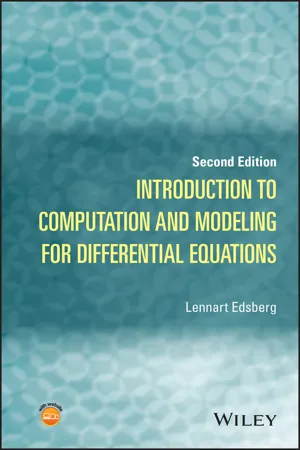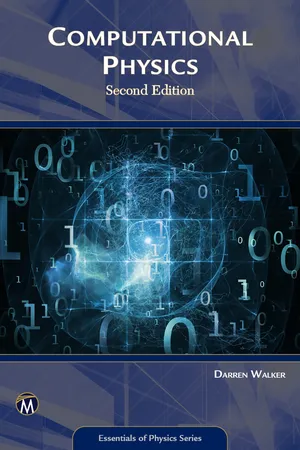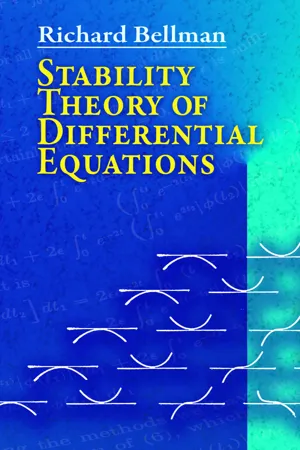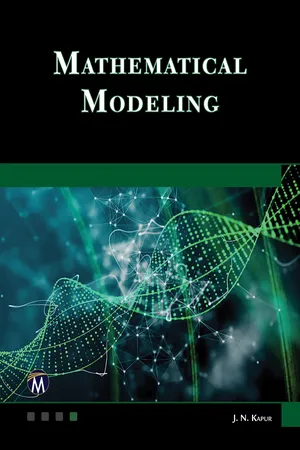Mathematics
Second-order Differential Equations
Second-order differential equations are mathematical equations that involve the second derivative of an unknown function. They are commonly used to model physical systems and phenomena in fields such as physics and engineering. Solutions to second-order differential equations often involve finding the general solution and applying initial conditions or boundary conditions to obtain specific solutions.
Written by Perlego with AI-assistance
Related key terms
Related key terms
1 of 4
Related key terms
1 of 3
6 Key excerpts on "Second-order Differential Equations"
- Lennart Edsberg(Author)
- 2015(Publication Date)
- Wiley(Publisher)
Chapter 2 Ordinary Differential Equations This chapter is not intended to be a thorough treatment of mathematical properties of ordinary differential equations (ODEs). It is rather an overview of some important definitions and concepts such as problem classification and properties of linear ODE systems with constant coefficients and stability. These matters are important for numerical analysis of methods solving ODE problems. For a more extensive treatment of ODEs, it is recommended to consult some mathematical textbook, e.g., one of those referenced at the end of this chapter. 2.1 Problem Classification A general way of formulating a first-order scalar ODE is 2.1 where is defined in some interval, bounded or unbounded, and is a solution if satisfies (2.1) for all in the interval. The variable is called the independent variable and is called the dependent variable. The derivative can also be denoted or. As we have already pointed out, the general solution of (2.1) contains an arbitrary constant. Hence, the general solution is a family of infinitely many solutions. If we prescribe an initial condition (IC), the constant is determined and we get a unique solution, a particular solution. A scalar ODE of second order can be written as 2.2 The general solution of (2.2) contains two arbitrary constants and, i.e.,. Therefore, we need two conditions to determine and to get a unique solution. These conditions can be given in various ways. One way is to specify at two different values of, i.e., at and : 2.3 This way of specifying boundary conditions (BCs) to the second-order ODE (2.2) is called a boundary value formulation, and (2.2) and (2.3) define a boundary value problem (BVP). Other possible types of BCs will be shown in Chapter 4. Another way to specify conditions is by ICs- eBook - ePub
- Darren Walker(Author)
- 2022(Publication Date)
- Mercury Learning and Information(Publisher)
Using the method outlined above write a program that uses the fourth-ordered Runge–Kutta algorithm to adaptively integrate a differential function of your choice. My advice would be to use a simple differential equation that can be solved analytically for comparison to your adaptive routine. You should confirm that your routine is adapting to the local nature of the differential.6.3 SOLVING SECOND-ORDERED ODES6.3.1 Coupled 1st Order ODEsIt has been noted before that second-order ODEs occur most frequently in physics as they model many real physical systems. In general, we write a second-order ODE as. (6.27)Note that the function f has three variables namely the independent variable, the dependent variable, and the first derivative of the dependent variable.Although methods exist to solve higher-ordered differential equations, for example, finite difference method, it is far simpler to reduce the equation into a set of coupled first-order differential equations; the term coupled will become apparent shortly. We can do this by introducing secondary dependent functions such that and and thus we can rewrite Equation (6.27) as a pair of coupled, first-order ODEs:;.(6.28)They are coupled because the rate of change of variable is dependent on the variable , and the rate of change of variable is dependent on the variable contained in the function f . However, if we define and then Equations (6.28) can be rewritten in vector form, (6.29)or,(6.30)where and represent two-component vectors. Comparison of Equation (6.30) with Equation (6.18) shows that the problem of solving second-ordered ODEs is not primarily different from the first-ordered ODEs for which we have been developing solutions, only that now we have extra components.To illustrate this point, we can write Equation (6.1), which describes Newton’s second law of motion, as a pair of coupled first-order differential equations by introducing momentum as a secondary dependent variable. The momentum of a body of mass m in one dimension is defined as, (6.31)where is the velocity of the body at time t , and x - eBook - ePub
- Richard Bellman(Author)
- 2013(Publication Date)
- Dover Publications(Publisher)
CHAPTER 6THE SECOND-ORDER LINEAR DIFFERENTIAL EQUATION
1. Introduction. We now turn our attention to the second-order linear differential equation(1)Since it is virtually impossible to present a complete account of all that is known concerning the properties of the solutions of the above equation, we have rather attempted to present a cross section of theorems and techniques in such a fashion that the reader will have little difficulty in following original papers or in deriving new results.Although some of the results we state below are special cases of general theorems valid for linear equations of any order, the results for the most part depend very strongly upon the particularly simple form of (1). Even where this duplication exists, we shall not hesitate to present a proof applicable only to (1) if it illustrates an important and useful technique.The physical importance of equations of the above class can hardly be overestimated, and this accounts for the vast amount of research connected with (1). Mathematically, the equation presents a continual challenge to the skill of the analyst to extract as many properties of the solution as possible without the luxury of an explicit representation for u in terms of the coefficients k and l.We shall begin our discussion with some preliminary lemmas required in what follows. Then we shall turn to the questions of boundedness, oscillation, and asymptotic behavior of the solutions.2. Some Lemmas. In this section we gather together some results we shall call upon repeatedly below. Lemma 1 has already been stated and proved in Chap. 2, and Lemma 2 is a particularization of Theorem 3 of Chap. 1.Lemma 1. Let u,v ≥ 0, c 1 > 0, and u satisfy the inequality(1)Then(2)Lemma 2 . Let u 1 and u 2 be two linearly independent solutions of(3)for which the Wronskian(4)for all t. Then the general solution of the inhomogeneous equation - eBook - ePub
- J. N. Kapur(Author)
- 2023(Publication Date)
- Mercury Learning and Information(Publisher)
2MATHEMATICAL MODELING THROUGH ORDINARY DIFFERENTIAL EQUATIONS OF THE FIRST ORDER
2.1 MATHEMATICAL MODELING THROUGH DIFFERENTIAL EQUATIONS
Mathematical modeling in terms of differential equations arises when the situation modeled involves some continuous variable(s) varying with respect to some other continuous variable(s) and we have some reasonable hypotheses about the rates of change of dependent variable(s) with respect to independent variable(s).When we have one dependent variable x (say population size) depending on one independent variable (say time t ), we get a mathematical model in terms of an ordinary differential equation of the first order , if the hypothesis is about the rate of change dx /dt . The model will be in terms of an ordinary differential equation of the second order if the hypothesis involves the rate of change dx/dt .If there are a number of dependent continuous variables and only one independent variable, the hypothesis may give a mathematical model in terms of a system of first or higher order ordinary differential equations .If there is one dependent continuous variable (say velocity of fluid u) and a number of independent continuous variables (say space coordinates x, y, z , and time t ), we get a mathematical model in terms of a partial differential equation . If there are a number of dependent continuous variables and a number of independent continuous variables, we can get a mathematical model in terms of systems of partial differential equations .Mathematical models in terms of ordinary differential equations will be studied in this and the next two chapters. Mathematical models in terms of partial differential equations will be studied in Chapter 7 - eBook - ePub
- Wim van Drongelen(Author)
- 2018(Publication Date)
- Academic Press(Publisher)
Chapter 9 Differential Equations Introduction Abstract In this chapter we review ordinary differential equations (ODEs) as a tool to model dynamics. We present examples of how to formulate them based on the dynamical system that needs to be modeled, and demonstrate the mathematical techniques one can employ to solve the equation analytically. We show how to solve linear differential equations with and without a forcing term, the so-called inhomogeneous and homogeneous ODEs, respectively. To illustrate the analysis of these equations, ODEs with first-order derivatives (e.g., d c / d t) and second-order derivatives (e.g., d 2 c / d t 2) are used in the examples. Next, we show how higher-order ODEs can be represented as a set of first-order ones, and how this leads to a formalism in matrix/vector notation that can be efficiently analyzed using techniques from linear algebra. To complete the overview of the available tools for solving ODEs, the final part of this chapter briefly refers to application of Laplace and Fourier transforms (see also Chapter 12) to solve them. Keywords Characteristic equation; Dynamics; Eigenvalue; Forcing term; Linear homogeneous equation; Linear inhomogeneous equation; Ordinary differential equation (ODE) 9.1. Modeling Dynamics When modeling some aspect of a neural system, we can represent static variables with algebraic expressions, e.g., the concentration c of some chemical in the brain is 10 units, c = 10. Of course, we can make these expressions a bit more complicated; for instance, the concentration could also depend on some combination of other substances a 1 and a 2 : e.g., c = 5 a 1 + a 2 + 10. It is important to realize that the variables do not change with time or space. For that reason the value of this type of equation is limited to situations where we study properties that remain constant over the range and duration of our interest - eBook - ePub
- C. A. Silebi, William E. Schiesser(Authors)
- 2012(Publication Date)
- Academic Press(Publisher)
7Systems Modeled by Second Order Partial Differential Equations
In Chapter 6 we considered the modeling and simulation of convective systems described by first order PDEs. Additionally, many transport process systems function through diffusion processes, which, as we shall see, are modeled by PDEs first order in time and second order in space; these are parabolic PDEs. In the next chapter we will consider mixed convective-diffusion systems modeled by hyperbolic-parabolic PDEs. Before proceeding further with a discussion of specific applications, we now consider the generalization of the numerical method of lines (NUMOL) to second and higher order PDEs.7.1 Generalization of the Numerical Method of Lines
In Section 6.7 we considered some of the general features of the NUMOL solution of PDEs, principally the conversion of the PDEs to approximating ODEs, followed by the integration of the ODEs by established explicit and implicit algorithms. This discussion was limited essentially to first order PDEs containing the advection group. However, the NUMOL can be extended to more general systems of PDEs of the form(7.1)whereu 1 , u 2 , …,un= vector of dependent variables of length n to be computed by the NUMOLt = initial value independent variable, typically timef 1 , f 2 , …,fn= vector of RHS functions defined for a particular PDE problemx = vector of boundary value (spatial) independent variables, for example, [x, y, z ] for Cartesian coordinates, [r, θ, z ] for cylindrical coordinates, [r, θ, ϕ ] for spherical coordinatesNote that in accordance with the usual practice in the numerical analysis literature, we denote the dependent variable as u (rather than T as in Section 6.7 ). As usual, a subscript with respect to t or x indicates a partial derivative with respect to t or x . Also, we have departed from the usual notation for a vector, that is,uv u2 , …,unis used in place of [u 1 , u 2 , …,un]T , where the superscript T denotes a transpose . Bold face type is also used to denote a vector, for example, x = x, y, z or x 1 , x 2 , x 3 (or [x, y, z ]T , [x 1 , x 2 , x 3 ]T
Index pages curate the most relevant extracts from our library of academic textbooks. They’ve been created using an in-house natural language model (NLM), each adding context and meaning to key research topics.
Explore more topic indexes
Explore more topic indexes
1 of 6
Explore more topic indexes
1 of 4





